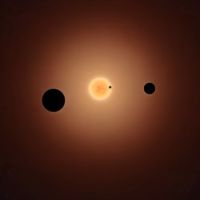Orbit
An Orbit is a mathematically closed path about a body in space by a ship or another body.
Description (Specifications)[edit]
Standard Orbits are defined as a measure of distance from a central star or stellar remnant. These are are typically measured in AU or Astronomical Units. These should not be confused with Orbital Zones which are temperature bands of importance when modelling system evolution, resources and habitability.
Other Orbits are defined relative to the nearest/largest near astronomical body.
Image Repository[edit]
- An IISS Scout Manual diagram of planetary orbits within a Star System.

Standard Orbit Representation[edit]
Standard orbits are represented numerically from 0 to 145. By convention orbit 3 is at 1 AU. Orbit 145 is the edge of an Astrographic Hex or Parsec and always represent the far system where Oort Clouds and the Hill Sphere are located.
Types of Orbit[edit]
Circumstellar Orbits[edit]
Stars (or stellar remnants) are the largest bodies in any system and form the focus for the orbits of Planets and Asteroid Belts.
Circumbinary Orbits[edit]
When two stars are relatively close together and the orbiting body a relatively long way away, Planets and Asteroid Belts may circle not the individual stars but the centre of mass of the pair. Such bodies are in Circumbinary Orbits.
Lagrangian Orbits inc. Trojan Orbits[edit]
Where one body orbits a second, there are stable and meta-stable points relative to the smaller body that can be exploited naturally (Trojan Points) or artificially. These are shown as L1, L2, L3, L4 and L5 in the diagram above. L2 is sometimes known as a Midnight Orbit as anything there is overhead on the smaller body at midnight. L4 and L5 are Trojan Orbits and are meta-stable - meaning that they may contain naturally occurring debris or even asteroids.
Resonant Orbits[edit]
Resonant Orbits (referred to as resonant chains) are where a number of bodies share orbital periods, around a central object, that are directly related to one another. This is expressed as an integer fraction, such as 2:1 or 4:3:2, and describes the number of orbits around the central object each body will make compared to the others over the same period of time.
Planetary Orbits[edit]
Low Orbits[edit]
These orbits are found between the upper atmosphere (if any) and the inside of the planet's radiation belt. For a Terran-sized planet, the orbital times are measured in minutes or hours. These orbits are typically affected by atmospheric drag and will naturally decay onto the planet
High Orbits[edit]
These orbits are found outside the planets radiation zone. These orbits may include a Geostationary Orbit (i.e. an orbit where one transit of the orbit takes the same time as one rotation of the underlying body) only if the planet is rotating at a speed that is significantly shorter than the planetary year. e.g. Terra has a Geostationary orbit at 36,000km; there is no equivalent for Luna.
High orbits end when the attractive force of another nearby astronomical object (Star or Moon) is greater than that of the Planet
Lunar Orbits[edit]
The principles are similar to Planetary Orbits (above)
Swapping/Horseshoe Orbits[edit]
Swapping/Horseshoe orbits occur when two astronomical objects occupy almost identical standard orbits. That in the lower orbit will slowly catch up with that in the higher and become attracted by it - thus raising its orbit (slowing it) and lowering the other object's (thus speeding it up) until the two have swapped tracks and are now moving away from each other again. They never pass each other in space within their shared orbit.
Star System Locations[edit]
See Orbital Zone
History & Background (Dossier)[edit]
Terran history shows that the concepts of Orbits were first discovered by Galileo, and developed by Johannes Kepler. Geostationary Orbits (and their implications) were first described by Arthur C Clarke.
See also[edit]
Universal world profile[edit]
- Main world
- Hex Number
- Universal World Profile
- Starport (Sp)
- Planetary Size (S)
- Atmosphere (A)
- Hydrosphere (H)
- Population (P)
- Government (G)
- Law Level (L)
- Tech Level (TL)
- Trade classification & Sophont Codes
- Importance Extension (Ix)
- Economic Extension (Ex)
- Cultural Extension (Cx)
- Nobility
- Bases
- Travel Zone
- PBG - Population, Belts, Giants
- P: Population Multiplier
- B: Belts
- G: Gas Giants
- Worlds
- Allegiance Code
- Stellar Data
References & Contributors (Sources)[edit]
| This page uses content from Wikipedia. The original article was at Orbit. The list of authors can be seen in the page history. The text of Wikipedia is available under the Commons Attribution-ShareAlike 3.0 Unported License. |
- Marc Miller. Imperial Encyclopedia (Game Designers Workshop, 1987), TBD.
- Frank Chadwick, Dave Nilsen. Traveller: The New Era (Game Designers Workshop, 1993), 192. (Main Rulebook)
- Martin Dougherty. A Guide to Star Systems (Mongoose Publishing, 2015), TBD.
- Marc Miller. T5 Core Rules (Far Future Enterprises, 2013), TBD.
- Author & Contributor: Lord (Marquis) and Master of Sophontology Maksim-Smelchak of the Ministry of Science

